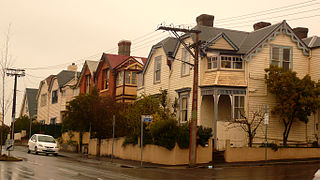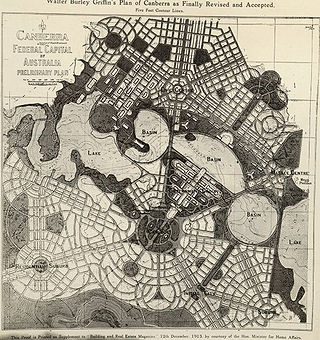John Bernard "Jack" Mundey was an Australian communist, union and environmental activist. He came to prominence during the 1970s for leading the New South Wales Builders' Labourers Federation (BLF) in the famous green bans, whereby the BLF led a successful campaign to protect the built and natural environment of Sydney from excessive and inappropriate development. Mundey was the patron of the Historic Houses Association of Australia.

Glebe is an inner-western suburb of Sydney in New South Wales. Glebe is located 3 kilometres (1.9 mi) southwest of the Sydney central business district and is part of the local government area of the City of Sydney, in the Inner West region.

Battery Point is a suburb of the city of Hobart, Tasmania, Australia. It is immediately south of the central business district. It is in the local government area of City of Hobart.

Juanita Joan Nielsen was an Australian newspaper owner, publisher, journalist, model, urban conservationist, and heiress. She disappeared after attending a meeting at the Carousel nightclub in Kings Cross on 4 July 1975. Her body has never been found.
Norman Leslie Gallagher was a controversial Australian trade unionist, and Maoist who led the militant Builders Labourers Federation as federal Secretary and as Victorian State Secretary.
Social movement unionism (SMU) is a trend of theory and practice in contemporary trade unionism. Strongly associated with the labour movements of developing countries, social movement unionism is distinct from many other models of trade unionism because it concerns itself with more than organizing workers around workplace issues, pay and terms and conditions. It engages in wider political struggles for human rights, social justice and democracy. Social movement unionism grew out of political struggles in developing countries and was theorized as a distinct industrial relations model in the late 1980s and early 1990s.
Campus Experience is the student organisation at Macquarie University and is a wholly owned subsidiary company of the University. The organisation manages Macquarie University's non-academic services of food and retail, entertainment, sport and recreation, student groups, child care and student publications. The organisation also houses an elected student representative council.
Verity Nancy Burgmann is Adjunct Professor of Politics in the School of Social Sciences at Monash University and Honorary Professorial Fellow in the eScholarship Research Centre at the University of Melbourne, where she is Director of the Reason in Revolt website. In 2013 she was Ludwig Hirschfeld Mack Visiting Professor of Australian Studies in the Institut für Englische Philologie at the Freie Universität Berlin.

Meredith Anne Burgmann is an Australian politician and Labor Party member and a former President of the New South Wales Legislative Council.

Victoria Street is a suburban street located in the inner eastern suburbs of Sydney, in the City of Sydney local government area of New South Wales, Australia. From south to north, Victoria Street goes through the suburbs of Darlinghurst, Potts Point and the locality of Kings Cross. It is 1.6 kilometres (0.99 mi) in length. In the section in Darlinghurst, the street is one-way, from north to south only.
The Fremantle Society is a community-based culture and heritage advocacy group in Fremantle, Western Australia. It was formed in 1972 to prevent demolition of historic buildings in Fremantle and to assist in their development. As the significance of Fremantle's built heritage came to be more widely recognised and respected, the focus of the Fremantle Society has evolved to include more of the cultural heritage of the area.
A by-election was held for the New South Wales Legislative Assembly seat of Mosman on Saturday, 29 July 1972. It was triggered by the retirement of the former Leader of the New South Wales Liberal Party and Minister of the Crown, Pat Morton.

The Builders Labourers Federation (BLF) was an Australian trade union that existed from 1911 until 1972, and from 1976 until 1986, when it was permanently deregistered in various Australian states by the federal Hawke Labor government and some state governments of the time. This occurred in the wake of a Royal Commission into corruption by the union. About the same time, BLF federal secretary Norm Gallagher was jailed for corrupt dealings after receiving bribes from building companies that he used to build a beach house.

Urban planning in Australia has a significant role to play in ensuring the future sustainability of Australian cities. Australia is one of the most highly urbanised societies in the world. Continued population growth in Australian cities is placing increasing pressure on infrastructure, such as public transport and roadways, energy, air and water systems within the urban environment.

The Bellevue Hotel was a hotel on the western corner of George and Alice Streets, Brisbane, Queensland, Australia. Once Brisbane's premier hotel, it was demolished in 1979 despite considerable public objection. In 2009 as part of the Q150 celebrations, the demolition of the Bellevue Hotel was announced as one of the Q150 Icons of Queensland for its role as a "Defining Moment".

The Kellys Bush Park is a heritage-listed bushland, partly on the former site of smelting works, at Nelson Parade, Hunters Hill in the Municipality of Hunter's Hill local government area of New South Wales, Australia. It is also known as Weil Park and The Smelting Company. The property is owned by Department of Planning and Environment, a department of the Government of New South Wales. It was added to the New South Wales State Heritage Register on 2 April 1999.

Juanita Nielsen's House is the heritage-listed former house of murdered activist and journalist Juanita Nielsen at 202 Victoria Street in the inner city Sydney suburb of Potts Point in the City of Sydney local government area of New South Wales, Australia. It was built from 1855 and designed in the Federation filigree. It was added to the New South Wales State Heritage Register on 27 June 2014.

Squatting in Australia usually refers to a person who is not the owner, taking possession of land or an empty house. In 19th century Australian history, a squatter was a settler who occupied a large tract of Aboriginal land in order to graze livestock. At first this was done illegally, later under licence from the Crown.
The Pink Ban was a strike action, taken by the Builders Labourers Federation (BLF), at Macquarie University due to the expulsion of a gay man from student housing.
Lynette "Lyn" Syme (1948-2019) was an Australian political and labor activist, feminist and aboriginal land-rights advocate, recognized in her later years as a Wiradjuri elder of the Dabee people in what is current-day New South Wales.











